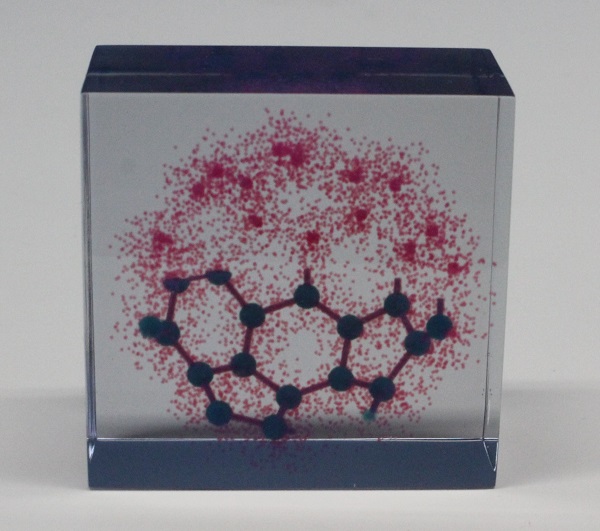Visualization of physical quantities in space using a 3D printer Modeling the electron density distribution of a molecule in transparent resin


Electron density distribution of fullerene (C60) modeled in transparent resin using a 3D printer
The red dots in this 5cm-square resin model represent electron density distribution (electron cloud). The lower half depicts an electron cloud superimposed on a ball-and-stick type molecular model representing atoms and interatomic bonds. The model makes it easy to grasp that the electron cloud is distributed equally around the nucleus of each carbon atom.
© 2017 Jun Yamazaki.
A University of Tokyo research group and their collaborators have developed a computer program that converts the distribution of physical quantities within space into data that can be printed three dimensionally. To demonstrate their program, the group fed data derived from the software into a 3D inkjet printer and successfully produced a transparent resin model depicting the electron density distribution of carbon atoms in a fullerene molecule resembling a soccer ball.
Understanding the relationships between molecular functions and the density distributions of how electrons are spread in an atom proved challenging as molecular models, representing the three-dimensional arrangement of atoms in a molecule, traditionally resorted to the ball-and-stick format to depict atoms (as balls) and interatomic bonds (as sticks).
The group led by Technical Specialist Jun Yamazaki of the University of Tokyo’s Institute for Solid State Physics succeeded in developing a program to convert the electron density distribution (electron cloud), which functions as interatomic bonds of a fullerene molecule (C60), into point cloud data. They fed these dot-like data points into a 3D inkjet printer and produced a molecular model with a visual representation of an electron cloud in transparent resin.
This type of molecular model makes it easier to grasp the distribution of electron density in a molecule, and should help in the development of new molecular functions involving electrons. Besides visualizing electron density, the new software can create visual representations of clouds, galaxies, architectural structures, airflow around automobiles, and other phenomena, and offers the possibility of a broad range of applications in a variety of fields.
“With the ball-and-stick-type molecular model, we faced the problem of not being able to express electron densities calculated on a supercomputer; but we resolved this with our current technology,” says Yamazaki. He continues, “It is fun thinking of ways to visually portray invisible physical quantities in transparent resin.”
“I was very impressed when we produced a beautifully crafted electron cloud with the program we created,” says Nagashiro. He adds, “I hope this software will contribute to the development of new sciences by elevating the visualization of computer simulation results with the electron density distribution from conventional two-dimensional images to three-dimensional representations using 3D printers.”
The current research was carried out in collaboration with Shinji Nagashiro of X-Ability Co., Ltd. and others.
Press release [PDF] (Japanese)
Paper
, "Development of STL files generation codes for molecular modeling incorporated with electron clouds using 3D-printer", Proceedings of the 30th symposium of Molecular Simulation Society of Japan p46-47.
Links
Institute for Solid State Physics
Center of Computational Materials Science, Institute for Solid State Physics (Japanese)






